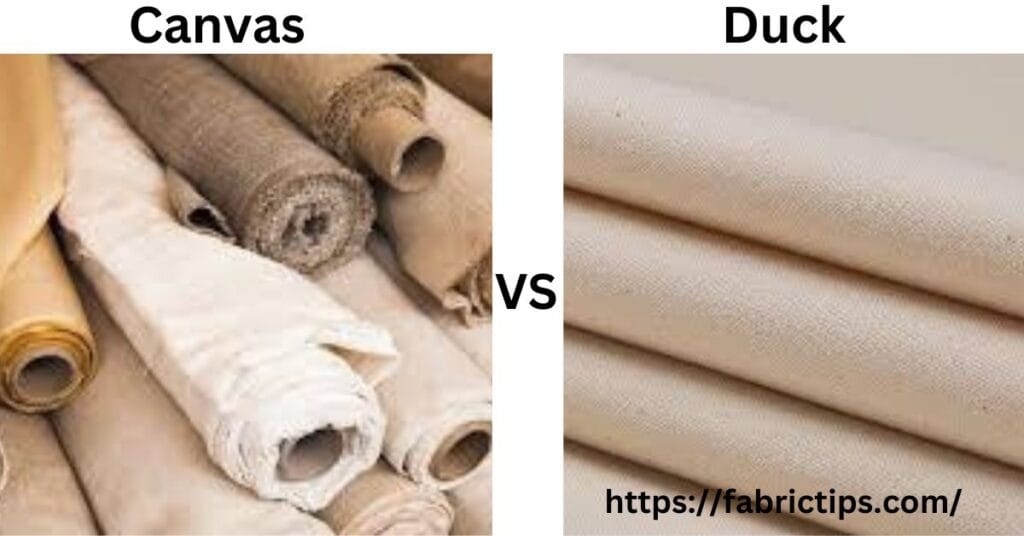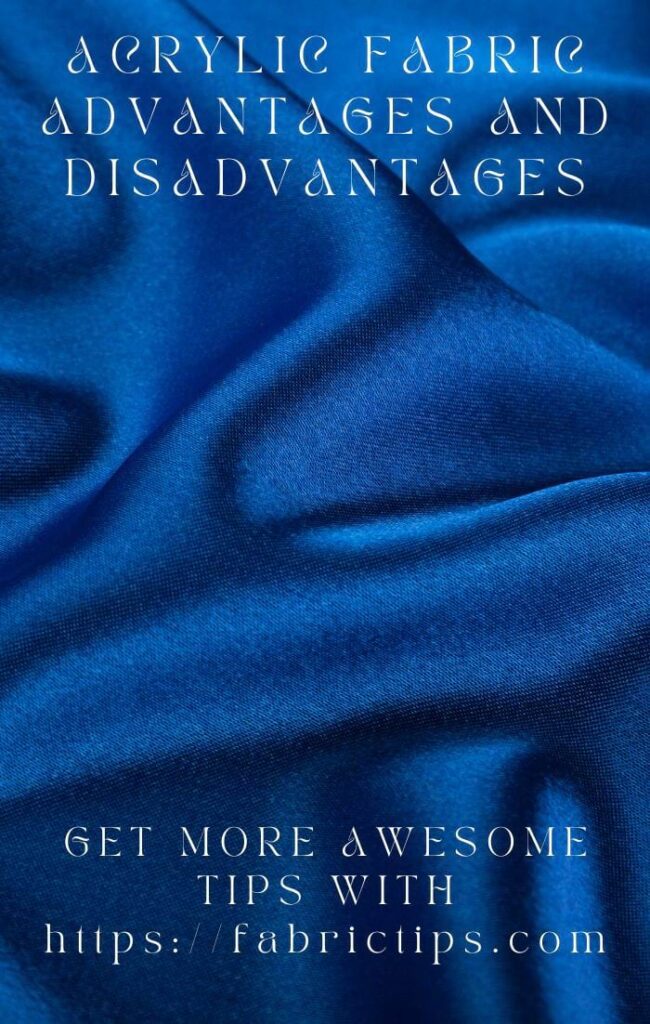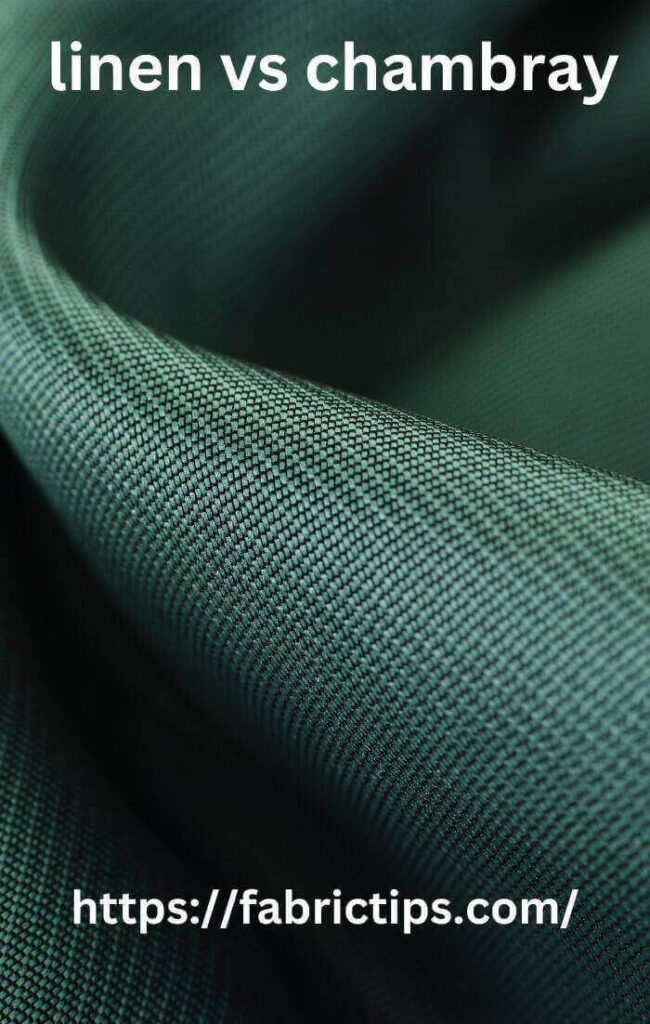Last Updated on December 13, 2025 by Wahid
While often used interchangeably, canvas and duck are not identical fabrics. Both boast impressive durability and a sturdy weave, but there are key distinctions to consider when choosing the perfect material for your project.
In a nutshell, duck is actually a type of canvas. Here’s a quick breakdown:
Canvas: A general term for a plain-woven fabric known for its strength and versatility. It comes in various weights and materials (cotton, linen, synthetics).
Duck: A heavy-duty cotton canvas with a particularly tight weave, offering superior strength and water resistance.
However, this guide delves deeper into the world of Canvas vs Duck, exploring their unique characteristics, applications, & when to choose one over the other.
What is Canvas Fabric?

Canvas is a plain-woven fabric, a timeless material boasting a rich history and a multitude of uses. Its construction is deceptively simple – a one-over-one weave pattern where warp threads (vertical) alternate with weft threads (horizontal). This seemingly straightforward approach yields a fabric renowned for its:
- Durability: The interlocking threads create a strong and stable material that can withstand wear and tear. This makes canvas ideal for applications like bags, tents, sails, & workwear where toughness is paramount.
- Versatility: Canvas isn’t a one-trick pony. It comes in a wide range of weights, from lightweight options perfect for clothing to heavyweight varieties suited for heavy-duty tasks. Additionally, canvas can be treated with various finishes, such as water repellency or flame resistance, further expanding its functionality.
- Paintability: Perhaps the most well-known characteristic of canvas is its smooth, receptive surface. This quality makes it a favorite among artists for creating paintings. The tight weave provides a sturdy pigment base, allowing for detailed and expressive artwork. In fact, the very word “canvas” is derived from the Latin word “cannabis,” referencing the hemp material historically used for artist canvases.
A Legacy of Strength:
The origins of canvas stretch back centuries. Evidence suggests its use in ancient Egypt for sails and mummy wrappings. Sailors throughout history have relied on canvas for its strength and wind-resistant properties. During the Middle Ages, canvas found its way into tents, awnings, and even armor due to its durability. As time progressed, canvas evolved beyond utilitarian purposes, becoming a popular material for clothing, footwear, & even bookbinding.
Why is it Called Canvas?
The exact origin of the word “canvas” remains a bit hazy, but the most likely explanation points to its historical connection with hemp.
Here’s the breakdown:
- Latin Root: The word “canvas” likely stems from the Latin term “cannabis,” which refers to the hemp plant.
- Hemp’s Historical Use: Hemp fibers were traditionally used to create a strong, plain-woven fabric ideal for sails, tents, and other utilitarian purposes. This use of hemp goes back centuries, with evidence suggesting its application in ancient Egypt.
- Evolution of the Term: Over time, as cotton became a more prevalent material for canvas fabric, the name “canvas” stuck, even though the fiber itself might have changed. The term became associated with the specific type of weave and the overall characteristics of the fabric, regardless of the material used.
So, while canvas fabric today is most commonly made from cotton, the name “canvas” serves as a reminder of its hempen origins and the long history of this versatile & durable material.
What is Duck Fabric?

Duck fabric takes the concept of canvas durability to a whole new level. While it shares the basic construction of a plain weave, duck boasts a significantly tighter weave, often using thicker yarns in the process. This denser weave is what elevates duck fabric to its champion status in terms of the following:
- Strength: Duck fabric can handle heavy loads and significant wear and tear without breaking a sweat. This makes it the perfect choice for applications where strength is paramount, such as heavy-duty bags, tarpaulins used for construction or covering equipment, & even marine applications like boat covers.
- Natural Water Resistance: The tight weave of duck fabric acts as a natural barrier against moisture. While not entirely waterproof, it offers a significant degree of water repellency, making it ideal for protecting your belongings from unexpected rain showers or splashes.
Beyond Strength & Repellency:
While strength and water resistance are the hallmarks of duck fabric, there’s more to this story. Duck’s tight weave also contributes to:
- Shape Retention: The dense weave allows duck fabric to hold its shape well, making it suitable for projects requiring structure, such as upholstery or bags that need to maintain their form.
- Abrasion Resistance: Duck fabric excels at resisting scuffs, scrapes, & everyday wear and tear, making it ideal for workwear or gear that might encounter harsh environments.
In the next section, we’ll delve into the possible origins of the name “duck” and how it compares to its canvas cousin.
Why is it Called Duck?
Unlike “canvas” with its clear Latin root, the origin of the term “duck” for this fabric remains shrouded in a bit of mystery. Historians and textile enthusiasts have proposed a couple of interesting theories:
Theory 1: A Corruption of “Duct”
- Some speculate that “duck” might be a corruption of the older term “duct,” which refers to a type of coarse linen fabric. This theory suggests a connection between the historical use of various sturdy natural fibers and the eventual dominance of cotton in duck fabric.
Theory 2: A Dutch Connection
- Another theory proposes a link to the Dutch word “doek,” which simply translates to “cloth.” This perspective suggests a more general term for a strong cloth that eventually became associated specifically with the heavy-duty cotton canvas we know today.
The Lack of Certainty Adds to the Allure
While a definitive answer regarding the origin of “duck” might be elusive, the very ambiguity adds a touch of historical intrigue to this fabric. Regardless of its etymological roots, duck fabric has established itself as a symbol of strength, durability, & functionality.
A Head-to-Head Showdown: Canvas vs Duck
Now that we’ve explored the unique characteristics of both canvas and duck fabric, let’s put them in a ring for a head-to-head comparison. By dissecting their key features side-by-side, you can choose the perfect material for your next project. Here’s a comprehensive table breaking down the key differences:
| Feature | Canvas | Duck |
| Material: | Cotton, linen, synthetics | Cotton only |
| Weight: | Varies (lightweight to heavyweight) | Typically heavyweight |
| Weave: | Plain weave | Tight plain weave |
| Durability: | Durable | Superior durability |
| Water Resistance: | Varies | More water resistant |
| Drape: | More drape (depending on weight) | Less drape |
| Applications: | Bags, tents, clothing, art | Bags, tarpaulins, marine applications, upholstery |
| Cost: | Generally more affordable | Generally more expensive |
Benefits & Drawbacks of Canvas Fabric
Benefits
- Unmatched Versatility: Canvas truly lives up to its name. Available in a wide range of weights, from airy lightweights ideal for summer clothing to robust heavyweights perfect for sturdy bags, canvas caters to a multitude of projects. This variety extends to finishes as well. Canvas can be found untreated, dyed in various colors, or treated with water repellency or flame resistance, further expanding its functionality.
- Budget-Friendly Choice: Compared to its heavyweight cousin, duck, canvas is generally more affordable. This makes it an excellent option for budget-conscious crafters or those experimenting with new projects. The wider range of weights also contributes to affordability, as lightweight canvas options are particularly cost-effective.
- Flexibility with Drape: For projects requiring a flowing drape or a softer feel, canvas offers a clear advantage. Lighter-weight canvas varieties drape beautifully, making them ideal for creating garments, tote bags, or even tablecloths. This draping quality allows for creative freedom and a wider range of design possibilities.
Drawbacks
- Strength Considerations: Canvas, especially lightweight varieties, may not be as strong as duck. For heavy-duty applications requiring maximum load-bearing capacity, the duck’s superior strength reigns supreme. Consider the weight & stress your project will encounter when choosing between canvas and duck.
- Variable Water Resistance: Canvas’s water resistance depends heavily on weight and treatment. Untreated lightweight canvas might offer minimal protection from moisture, while treated canvas can provide some degree of repellency. For projects requiring significant water resistance, duck’s naturally water-repellent tight weave is a better choice.
Yes, by understanding both the benefits and drawbacks of Canvas, you can make informed decisions about its suitability for your specific needs.
Benefits & Drawbacks of Duck Fabric
Benefits
- Unmatched Strength: Duck is the undisputed heavyweight champion in the world of canvas fabrics. Its tight weave and robust cotton construction allow it to handle heavy loads and significant wear & tear without breaking a sweat. This makes it the perfect choice for applications like heavy-duty bags used for construction materials or tools, tarpaulins for covering equipment outdoors, or even marine applications like boat covers that need to withstand harsh weather conditions.
- Natural Water Repellency: Mother Nature equips duck fabric with inherent water-resistant qualities. The dense weave acts as a barrier against moisture, protecting your belongings from unexpected rain showers or splashes. While not entirely waterproof, duck fabric offers a significant degree of water repellency, making it a reliable choice for projects requiring some level of moisture protection.
- Shape Retention Like No Other: Due to its tight weave, duck fabric excels at holding its shape. This characteristic makes it ideal for projects where maintaining structure is crucial. Upholstery applications benefit from duck’s ability to retain its form, while bags designed to maintain a specific silhouette can leverage this advantage.
Drawbacks
- Limited Options: Unlike canvas, duck typically comes in heavyweight options. This lack of variety in weight might restrict its use for projects requiring lighter, more flexible materials. If your project prioritizes drapes or a softer feel, canvas might be a better choice.
- Stiffness Can Be a Challenge: The tight weave contributing to duck’s strength can also make it less flexible. For projects requiring a flowing drape or intricate folds, duck’s stiffness might pose a challenge. Understanding this limitation helps in choosing the right fabric for projects with specific flexibility needs.
- Cost Considerations: Due to its focus on pure cotton and superior strength, duck fabric generally comes with a higher price tag compared to canvas. When budget is a major concern, canvas offers a wider range of more affordable options.
However, by carefully weighing the benefits and drawbacks of duck, you can determine if it’s the perfect match for your project’s requirements.
Similarities & Differences: Choosing the Perfect Fabric
As we’ve explored, both canvas & duck are exceptional fabrics, each with its own strengths and characteristics. Here’s a quick recap of the key similarities:
- Plain Weave Construction: Both fabrics utilize a basic plain weave pattern, offering stability and durability.
- Renowned for Strength: Canvas and duck are both known for their ability to withstand wear and tear, making them ideal for long-lasting projects.
- Shared Applications: They share some common applications, such as bags and upholstery, where durability is a priority.
However, there are also distinct differences to consider:
- Duck: The Strength Champion: Duck is a specific type of canvas renowned for its exceptional strength & natural water resistance, making it ideal for heavy-duty applications.
- Canvas: The Versatile Choice: Canvas offers a wider variety in weight, material (cotton, linen, synthetics), and drape, catering to a broader range of projects & design possibilities.
- Stiffness and Cost: Duck’s tight weave can make it stiffer and generally more expensive than canvas.
Canvas vs Duck: What to Choose?
There’s no single “winner” in the battle between canvas and duck. The best choice depends entirely on your project’s specific requirements. Consider these factors when making your decision:
- Strength Demands: For projects requiring maximum load-bearing capacity & resilience, duck’s superior strength reigns supreme.
- Water Resistance Needs: If water repellency is crucial, duck’s natural water resistance might be the better option. However, treated canvas can also offer some degree of protection.
- Flexibility & Drape: For projects requiring a flowing drape or a softer feel, canvas, especially lightweight varieties, is a clear choice.
- Project Budget: Canvas generally offers more affordable options, especially if budget is a major concern.
Actually, by understanding the unique properties of both canvas and duck, you’re well-equipped to make informed decisions & choose the perfect fabric to bring your project to life.
FAQs
Here are common FAQs about Canvas vs Duck fabric, addressing questions people often ask on Google, Reddit, Quora, and other forums:
Is canvas stronger than duck?
Not necessarily. Duck fabric is specifically designed for superior strength due to its tighter weave and heavier weight. However, heavyweight canvas can be quite strong for many applications.
Is duck fabric waterproof?
Duck fabric offers natural water resistance due to its tight weave, but it’s not entirely waterproof. For complete waterproofing, additional treatment might be necessary.
What is canvas best used for?
Canvas’s versatility shines in projects like bags, tents, clothing, and even artist canvases. Its range of weights and finishes allows for various applications.
What is duck fabric best used for?
Due to its exceptional strength and water resistance, duck excels in heavy-duty bags, tarpaulins, marine applications, and upholstery where shape retention is crucial.
Is canvas or duck better for bags?
It depends on the bag’s purpose. For everyday totes, canvas offers good durability and affordability. For heavy-duty bags carrying significant weight, duck’s strength is ideal.
Can I use canvas for outdoor furniture?
Treated canvas options with water resistance can work for outdoor furniture cushions. However, for long-term outdoor use, duck or solution-dyed acrylic fabrics might be more suitable due to superior weather resistance.
Is duck fabric too stiff for clothing?
Yes, generally. Duck’s tight weave makes it less flexible than canvas. Lightweight canvas is a better choice for clothing due to its softer drape.
How can I tell the difference between canvas & duck fabric?
Feel the fabric. Duck will have a noticeably tighter weave and feel stiffer compared to canvas. You might also encounter labels specifying the material (cotton for duck).
Is canvas or duck more expensive?
Generally, duck fabric is more expensive than canvas due to its focus on pure cotton and superior strength. Canvas offers a wider range of materials and weights, including more affordable options.
Are there any vegan alternatives to canvas and duck?
Absolutely! Recycled polyester canvas and organic cotton canvas are excellent eco-friendly choices that offer similar benefits to traditional canvas. Additionally, hemp canvas is another natural and vegan alternative gaining popularity.
How do I clean canvas and duck fabric?
Both fabrics benefit from gentle cleaning. Spot cleaning with a mild detergent and air drying is usually recommended. Always check the care label for specific instructions, especially for dyed or treated canvas.
Can I paint on duck fabric?
While technically possible, duck fabric’s tight weave might not be ideal for painting. The smoother surface of artist’s canvas (typically made from linen or cotton) provides a better base for paints to adhere and create detailed artwork.
Conclusion
Throughout this exploration, we’ve delved into the world of canvas and duck fabrics, uncovering their strengths, weaknesses, and ideal applications. While often used interchangeably, these fabrics boast distinct characteristics that can make a world of difference in your project’s outcome.
Remember:
- Canvas: The versatile champion offering a wide range of weights, materials, & drapes. Perfect for projects requiring flexibility, affordability, or a paintable surface (think artist canvases!).
- Duck: The heavyweight champion of strength and water resistance. Ideal for heavy-duty bags, tarpaulins, marine applications, or projects requiring exceptional shape retention.
The final verdict? It depends! Consider your project’s specific needs for strength, water resistance, drape, & budget to make the perfect choice between Canvas vs Duck.
Finally, the next time you reach for fabric, you’ll be a canvas and duck connoisseur, equipped to select the ideal material to bring your creative vision to life!


